Why Is Food Safety Important In Healthcare? Healthcare Leaders Guide
Learn challenges healthcare foodservice teams face today and key food safety practices to protect vulnerable patients. Get a free healthcare leader...
Walmart's growth as an online grocer continues to soar. Are you ready to sell on their marketplace?
Do you think Sam Walton, the found of Walmart, envisioned the impact that Walmart as we know it today would have on communities and entrepreneurs around the world?
Online marketplaces are one of the reasons businesses of all shapes and sizes have been able to successfully scale. It was no accident when Walmart made the brilliant decision to invest in their eCommerce offerings.
Since its inception of online shopping on Walmart.com in 2000 and the launch of third party selling in 2009, Walmart has created a seamless and convenient shopping experience for their customers. In fact, in the United States alone, 90% of the population has a Walmart location within 10 miles of where they live.
WHAT WE'LL COVER:
Online shopping, in-store shopping — it doesn't matter. You can access the products you need by walking into Walmart yourself or by having it delivered to your doorstep at the tap of a finger.
As a food business, you understand the opportunity in getting your food brand and products in front of your group of Walmart's 133.6 million monthly visitors (as of January 2024).
If you're wondering how to sell food on Walmart Marketplace, there are generally two roads you can go down:
Regardless of the road you choose, there are benefits to either one. Let's quickly break down the main differences.
In this article, we'll be exploring the ins and outs of selling food on Walmart Marketplace. But first, let's differentiate between the two types of sellers.
Walmart Marketplace describes itself as "a community of established, professional sellers whose high-quality assortments complement the first-party offerings on Walmart.com." And it's no surprise that Walmart is one of the fastest-growing North American eCommerce platforms.
In fact, they're the second largest online grocery seller with $2.4 billion in sales, trailing Amazon ($8.2 billion) and Kroger ($1.8 billion), with the pandemic spurring their eCommerce growth by 74%.
The effect is two-fold: established brands see the growth lever to increase sales thanks to Walmart's reach; newer brands see the opportunity to start scaling with relative ease.
Like selling food on Amazon, Walmart Marketplace allows food businesses to sell products on their eCommerce platform with little to no barriers to entry. Walmart Marketplace sellers, big and small, generally fall into three categories:

Naturally, the relationship between Walmart and its suppliers grows in complexity when exploring the possibility of offering products in physical stores. Walmart suppliers include any business that provides them with products for both resale and Walmart’s own use.
Walmart suppliers are typically expected to, before the application process, have a positive brand reputation, an already established business and all relevant food safety certifications (e.g., a Global Food Safety Initiative recognized audit standard).
Walmart prides itself on high-quality standards and we're seeing a growing number of businesses seeking food safety software like FoodDocs to ensure they're GFSI-compliant. This means maintaining standards such as:

Thank you for downloading Food product specification sheet!
Want to get a customizable HACCP template?
Or set up your food safety system in 15 minutes?
Next, let's jump into some impressive Walmart statistics and the reasons why you should seriously consider selling your food on Walmart Marketplace.
Let's start with a few of Walmart's eCommerce statistics:
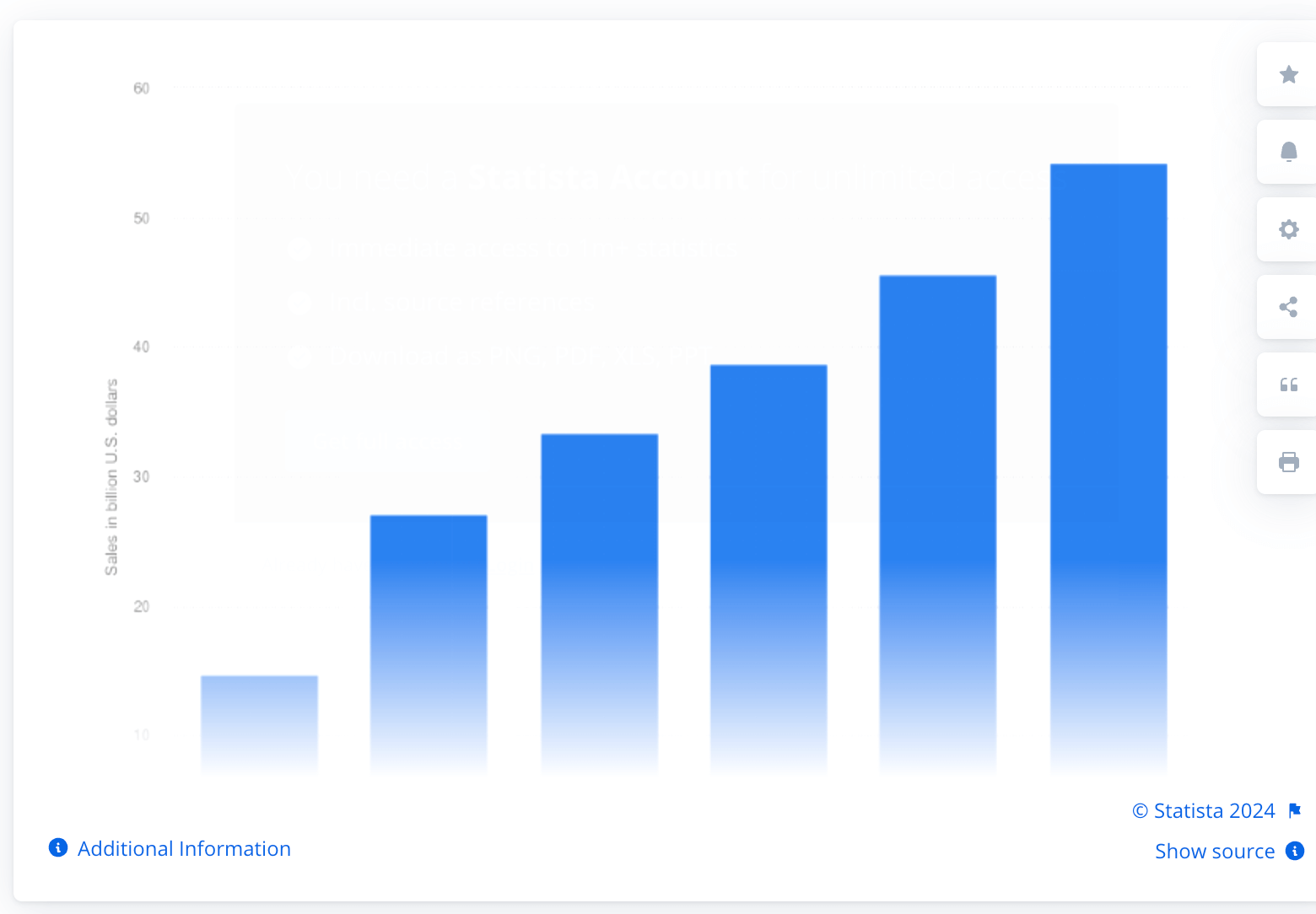
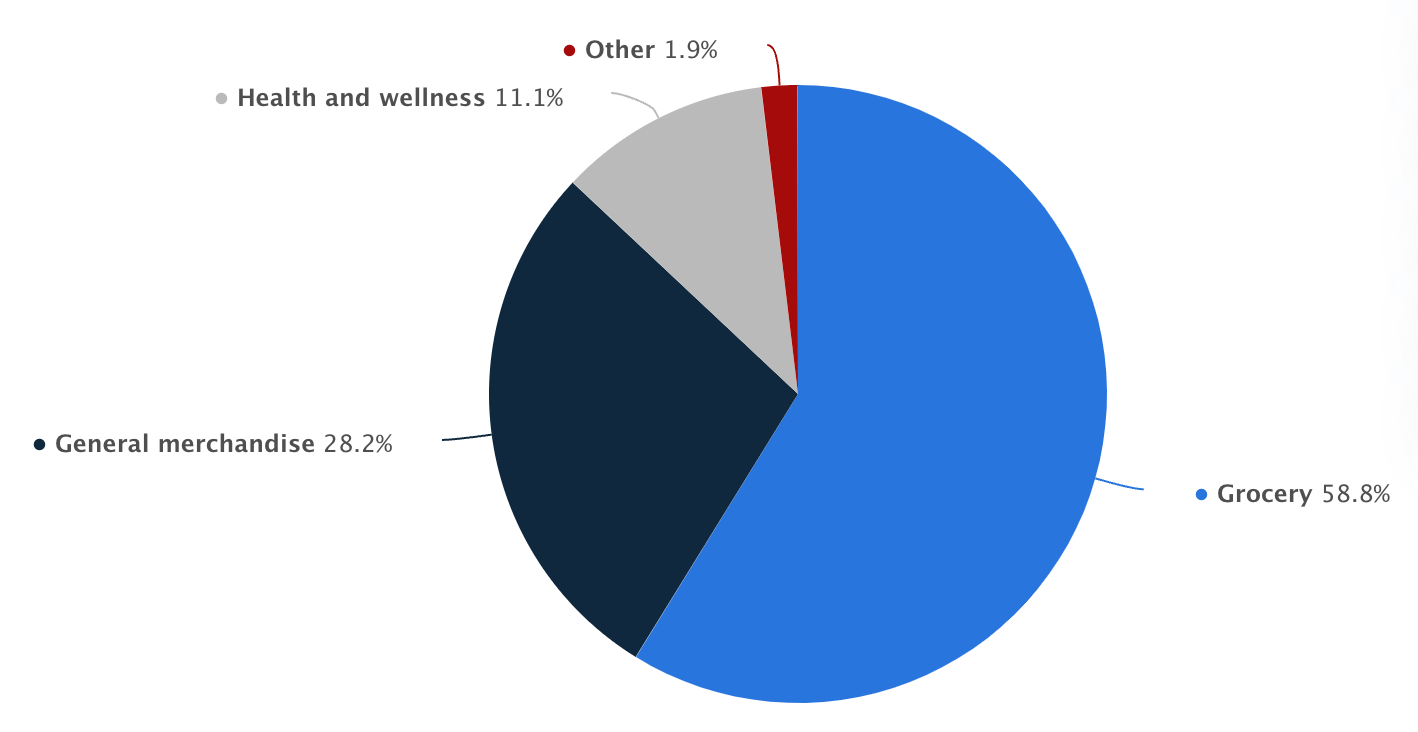
While those figures include groceries from suppliers as opposed to just Walmart Marketplace sellers, they're significant and suggest that people choose (and will continue to choose) Walmart to buy food.
In order to take advantage of these awesome Marketplace benefits, the signup and onboarding process is simple.
Do yourself a favor and make your Walmart Marketplace application process as smooth as possible. How? By making sure you compile the minimum information that they require:
There are three main steps to becoming a seller on Walmart:
Here's where you'll input your Country or Region of incorporation and Employer Identification Number. Let's assume you choose United States.
In your business details, you'll add the legal business name, business address, contact information, website, yearly gross merchandise value, and highest performing category. In this case, you'd choose food.
Lastly, you'll fill out Seller profile info which is public information that customers can use to contact you. It includes your Walmart.com display name and customer service phone number and email address.
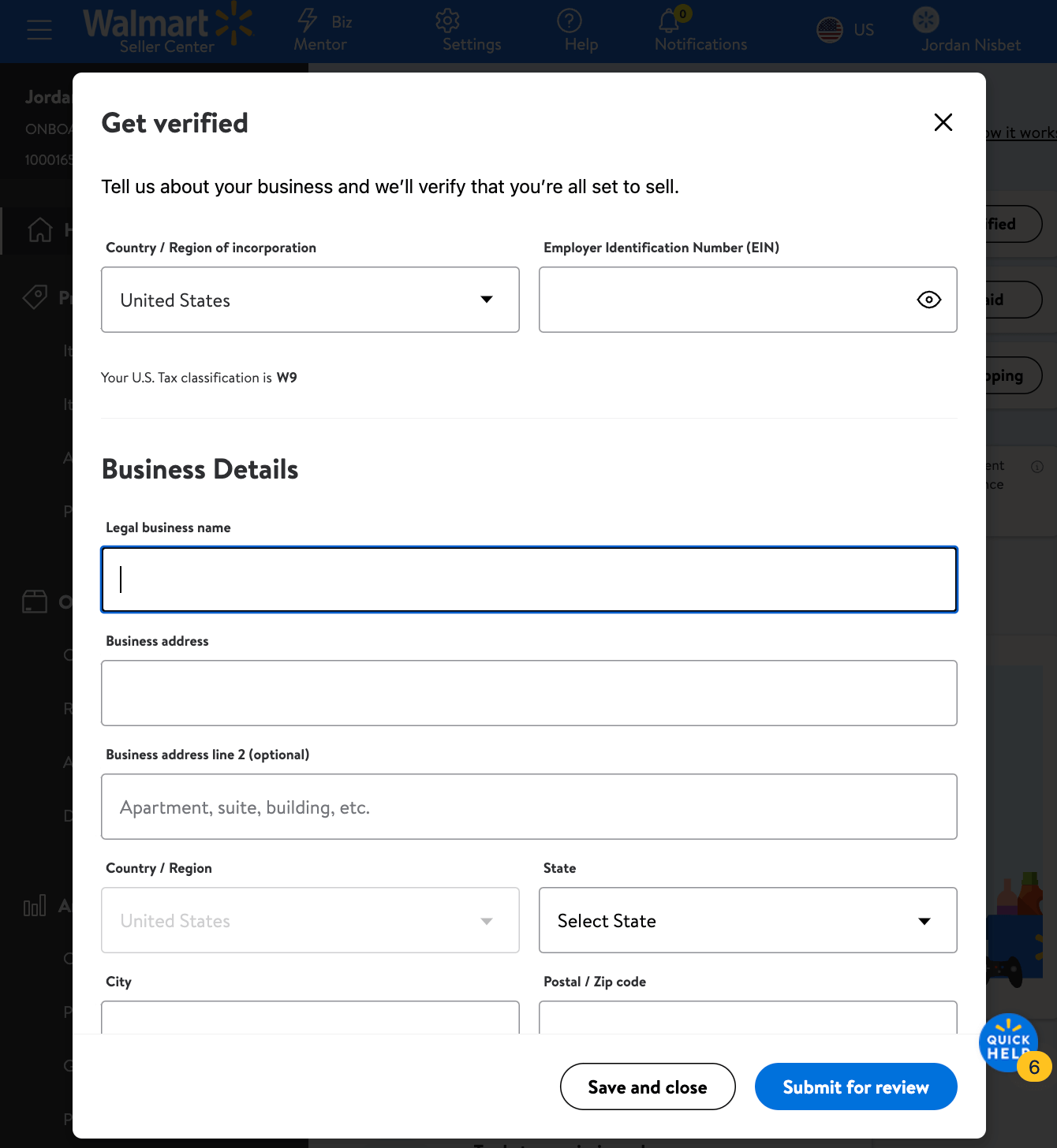
During the setup process, Walmart Marketplace displays a handful of payment partners:
In order to set up your payment method, your business verification in step one will need to be complete and approved. If that's the case, you'll be able to set up your business to receive payments with ease.
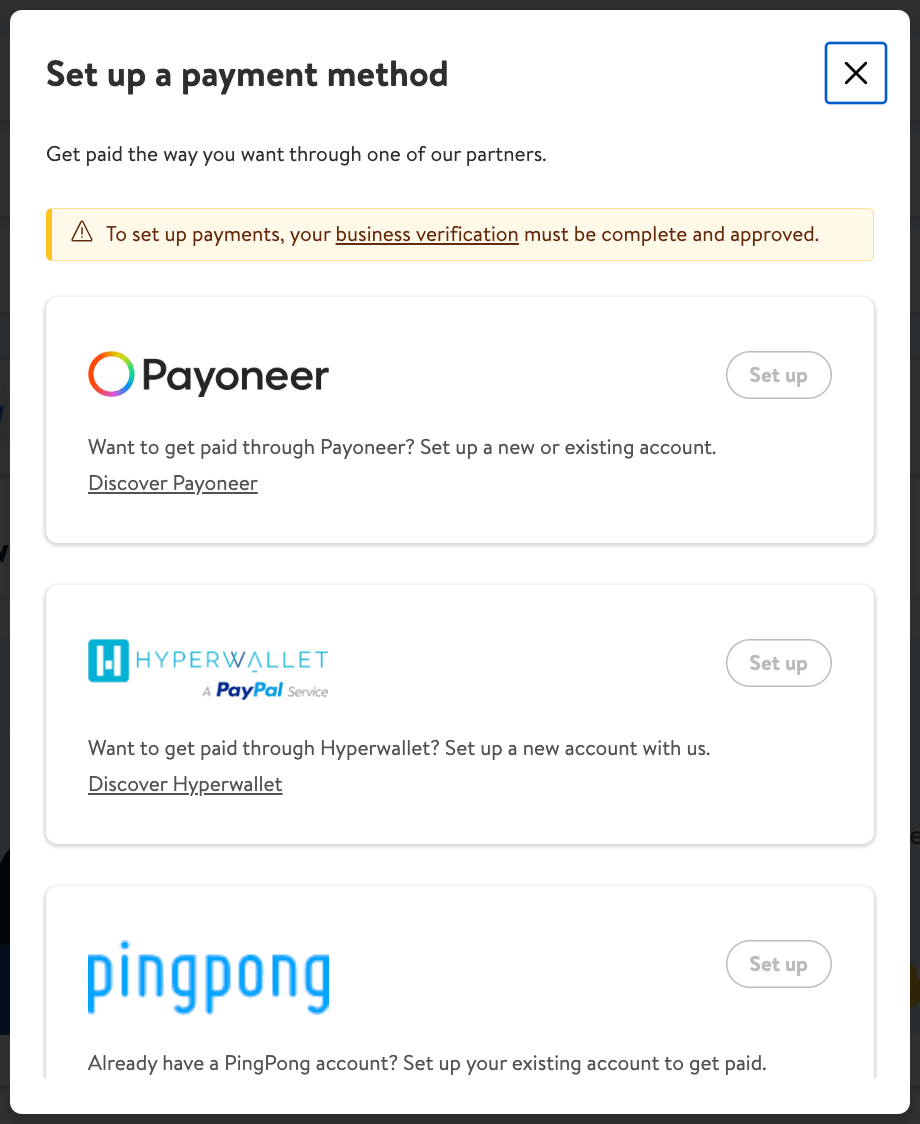
In order to set up shipping and returns for your food business, you'll select up to two types of Shipping Templates:
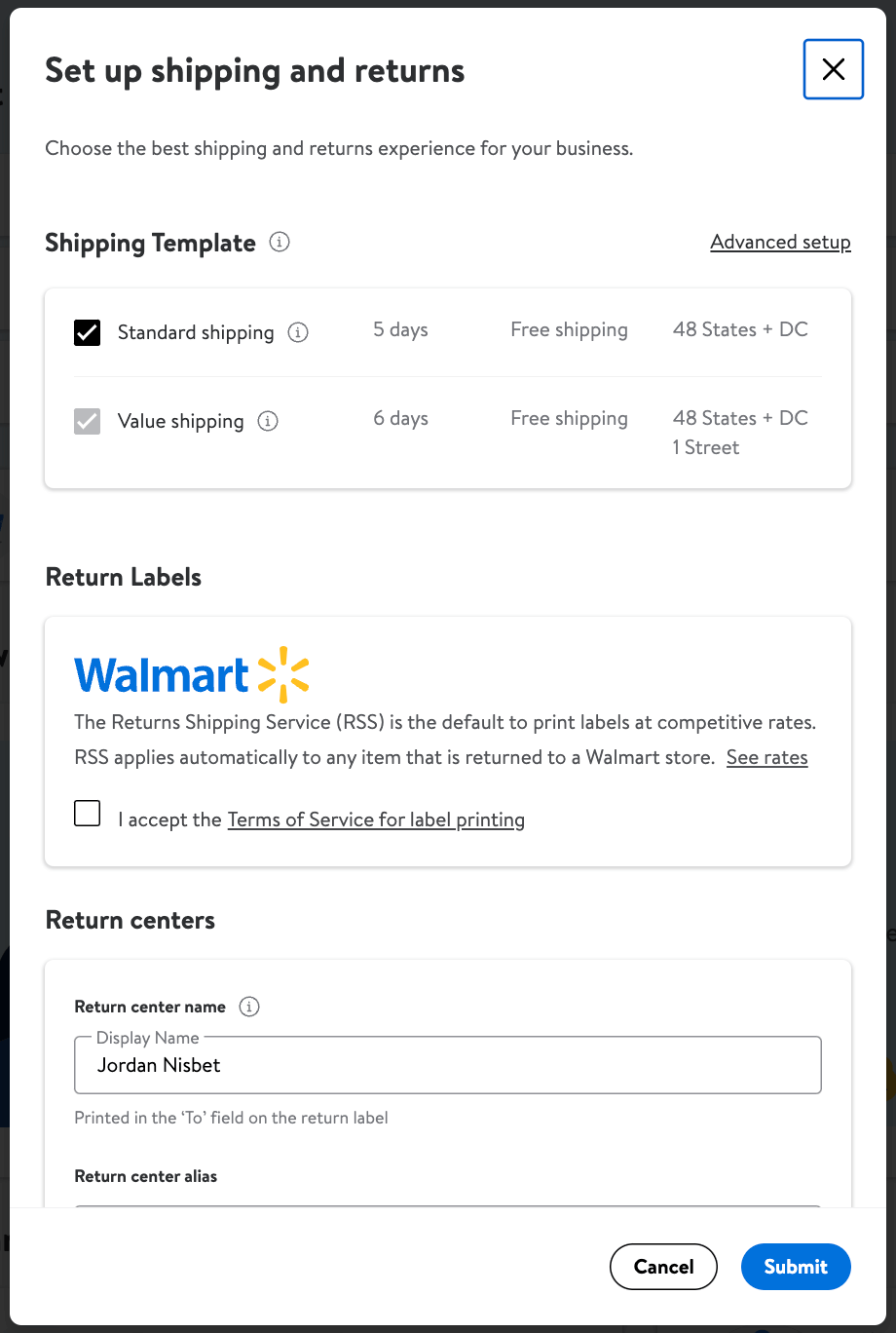
If you're food business operations don't fit those default template settings, you do have the ability to edit shipping details in the advanced settings. They include:
You'll also need to accept the Return Labels Terms of Service and fill out your return center details.
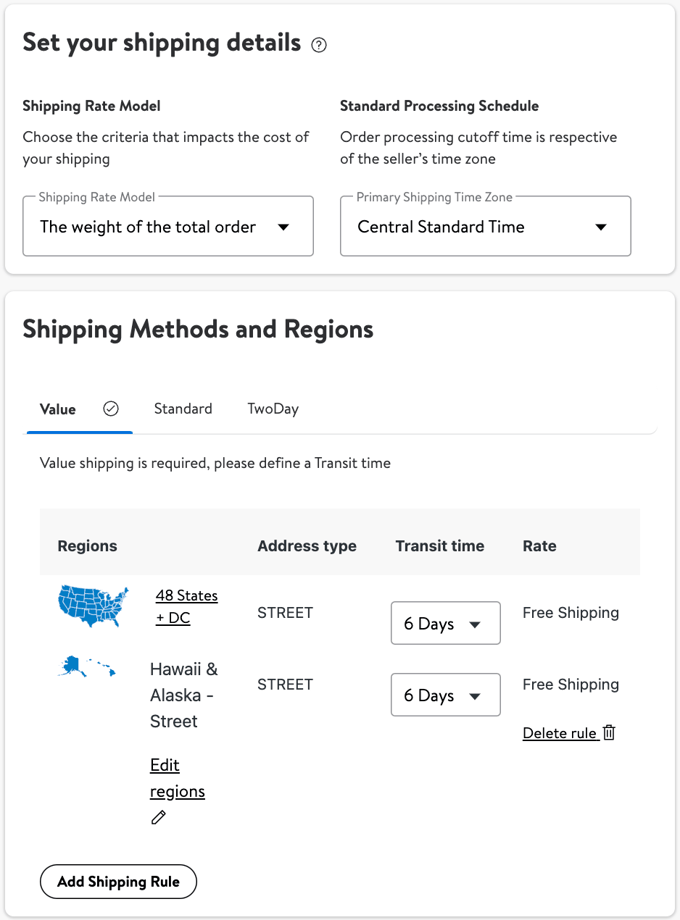
Once you submit the information for these three steps, you don't need to wait for approval to start setting up your food listings in your Product Catalog.
The only caveat is that they'll be saved as drafts until the above steps are approved by Walmart Marketplace's account reviewers. But we suggest getting as set up as possible so you can start selling faster.
There are different methods of listing your food products on Walmart's selling platform.
Uploading a spreadsheet saves you a lot of time and effort. This is particularly helpful if you sell more than a few food products. In Seller Center on the Home page, select "Build your Catalog", "Add items", and then browse or drag-and-drop your XLSX spreadsheet file to upload your food product catalog.
As a best practice, make sure that the file is no more than 5 megabytes and, at the minimum, includes:
And don't worry — this isn't final. You'll be able to edit, remove, and add information as needed once your spreadsheet is uploaded and converted in Seller Center.
You can also take advantage of Walmart Marketplace's Bulk Upload tool, which makes it easy to manage products across multiple categories.
It's worth noting that you can leverage Walmart's solution providers if you sell on multiple marketplaces and want to outsource all of your food business's item setup, inventory, pricing, etc.
You can work with them to use Walmart's Marketplace API to do all of your food product listing management, ordering, pricing, and inventory.
Your best best is to search the Walmart catalog and set up by matching. Once you search for your desired food product — let's say you want to sell Cadbury mini eggs — you'll specify the offer details which include:
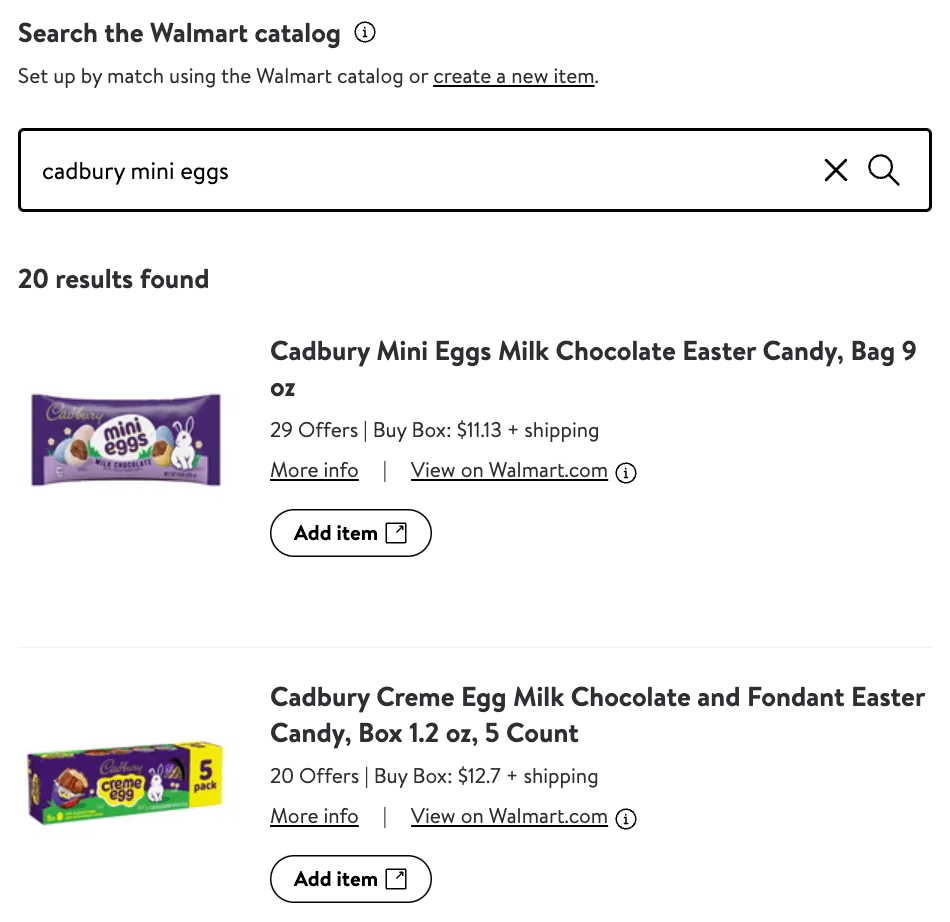
You can use the product listing upload method that we just shared above. Or, you can use Seller Center to search for a product identifier such as the UPC, GTIN, ISBN, or Walmart Product ID.
This is a nice option because for food businesses with a single product or smaller catalog because it automatically includes the necessary data needed to add the item.
Generally, cost varies based on your selling category. The Grocery category specifically has competitive referral fees of:
Now that we've covered the technicalities of getting your Walmart Marketplace account set up in Seller Center, let's cover an often overlooked aspect of selling grocery products on eCommerce platforms...
And that's food safety.
Walmart takes their food safety culture seriously.
"As the world’s largest grocer, we help people all over the world save money and live better. We are committed to playing a leading role in providing access to safe, high-quality foods for our customers," says Doug McMillon. "The Global Markets (GM) Programme gave us the opportunity to work with small and developing suppliers in markets where GFSI adoption fell short of Walmart’s requirements. Our GM approach enables suppliers to obtain an assessment from select certification bodies. After passing an audit, suppliers must commit to working towards full certification within two years."
Below, we cover what we deem the most important aspects of Walmart Marketplace's Prohibited Products Policy. But you can also read it in full on their Seller Help pages.
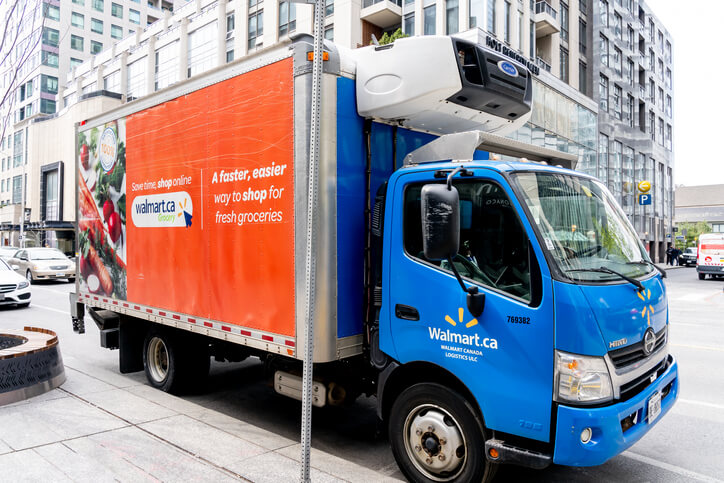
According to Walmart's Prohibited Product Policy, food along with any other Walmart Marketplace items must comply with any applicable laws and regulations, from the local to federal levels.
These laws and regulations vary from country to country and state/province to state/province. As a Walmart Marketplace seller, you should expect and be prepared to promptly provide them with information about your business's food safety plan.
"Walmart generally expects all suppliers’ plants to be certified to a Global Food Safety Initiative-benchmarked standard and we will ask you to provide evidence that your plant is certified. We may ask you to provide other evidence that you are managing food safety hazards effectively, including our expectations regarding compliance with our minimum product microbiological and chemical requirements. Finally, we expect you to report any safety issues to us immediately."
As you'll see in the next section about prohibited foods, if you're strictly selling on Walmart Marketplace, it's very clear what foods are and are not allowed (unless you become a private brand supplier).
But let's say your food business sells vegetable crisps or canned goods, you'll likely already be required by your government to have a license to sell food and even a food safety management system in place.
So having these paper or digital documents ready to submit as proof for your business is a wise step to take. This could be your food safety plan, internal audits, as well as any monitoring or traceability logs you keep.
Regarding product labels, listing information and images, all of it must be in English. If necessary, you can present those things in other languages so long as the English version is present.
When creating your product listings, you must also include the name and details as it appears on the product label.
If you fail to adhere to these policies, Walmart will remove the product listing in question. You'll likely have the ability to take corrective actions, however, they can also suspend or even terminate your account.
FoodDocs is a smart food safety software that makes compliance with your food safety standard of choice easy.
From a time-saving food safety plan builder to customizable monitoring and traceability logs with built-in task verification — all brought together with a convenient mobile app — FoodDocs helps small to medium food businesses get and stay compliant. See FoodDocs full suite of food safety solutions.
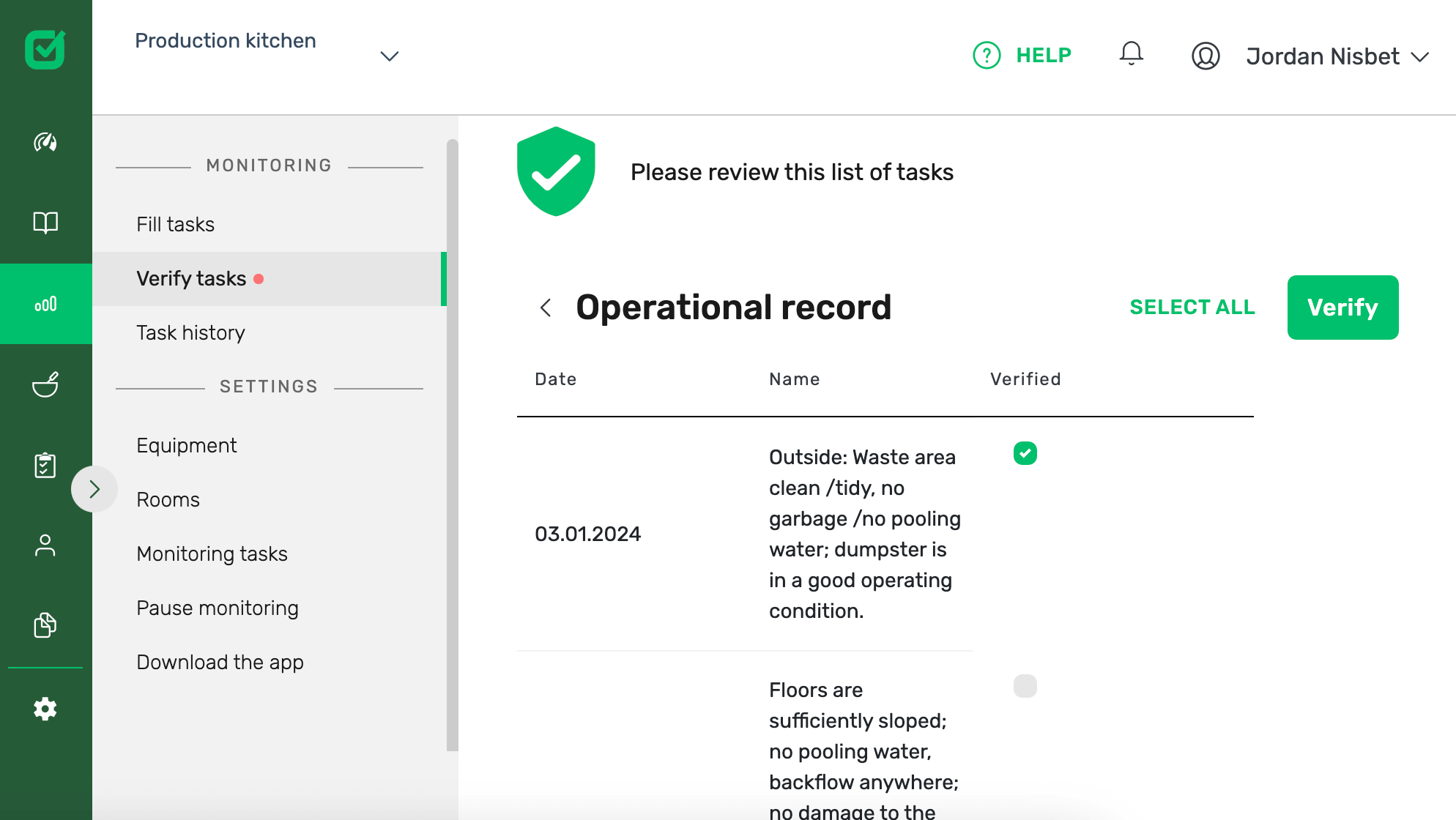
Preview of FoodDocs' task verification feature within its Monitoring product.
As a food business, this brief section is particularly important if you want to meet compliance and have your edible products listed without a hitch.
No aspect of your food products throughout any part of the manufacturing process — from ingredient sourcing and extraction to production and transportation — can involve the following places:
Compared to Amazon's Grocery & Gourmet Foods category, food is not listed as one of the categories that require pre-approval. Pre-approval is required for businesses selling:
There are, however, specific food categories that do have prohibited products.
While suppliers go through a more intensive application and approval process to be able to sell groceries online and in stores, Walmart generally disallows Marketplace sellers from selling:
So what is allowed to sell? Thankfully, Walmart Marketplace is pretty clear on what foods are prohibited, allowed with restriction, and allowed.
Prohibited fresh foods include:
Fresh foods that are allowed with restrictions include:
Uncut chocolate-covered uncut strawberry gift sets that are safely packaged for shipping
Fresh foods that are allowed:
Other food products specifically approved for sale
Businesses are not allowed to sell food products on Walmart Marketplace if they're:
Other foods in this prohibited category include:
Foods that are allowed in this category include:
Other safe and unadulterated shelf-stable foods.
This category has a lot to do with food safety marketing regulations and proper labeling requirements.
Prohibited foods include those which make a(n):
Foods that are allowed with restrictions include:
Foods that business can sell on Walmart Marketplace in this category include:
Walmart Marketplace also has specific policies for medical foods and pet foods, supplements, and medicines. In this article, our priority focus is on the Food Products category but if you're in the business of pet- or medical-related foods, do explore the links above.
Venturing onto eCommerce platforms like Walmart Marketplace, Amazon and others will require that you prove your business's commitment to food safety.
As you scale, food safety becomes more and more challenging to manage. You might go from single-digit monitoring checks per day to tens depending on the type of business you're growing. And doing this with pen and paper is simply unmanageable.
That's why we built FoodDocs, which helps businesses like yours:

Learn challenges healthcare foodservice teams face today and key food safety practices to protect vulnerable patients. Get a free healthcare leader...
Learn what Standard Operating Procedures (SOPs) are and how to write effective SOPs that ensure consistency, efficiency, and safety in your...
Boost your retail food safety with essential practices and digital tools to protect customers and your brand. Plus a free Retail Food Safety Leader...